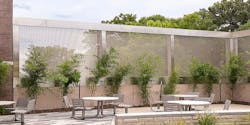Pandemic-level illness, a nation-wide mental health crisis, and healthcare worker burnout are fueling a reimagined future for America’s healthcare infrastructure. A recent study projects a pattern of stable growth for healthcare will continue, producing an increase in spending over the next several years. Healthcare was one of the few major construction sectors that did not see a decline during the pandemic.
As the demand for innovative hospitals, behavioral health centers, and ambulatory clinics continues to rise, woven metal fabric is an attractive, resilient, and dynamic material that can be used to construct positive patient experiences and environments that support both physical and mental healing.
Case Study: University of Washington Behavioral Health Center
The University of Washington Behavioral Health Center is a fully integrated healing environment designed for individuals struggling with serious physical and behavioral health problems. The Center offers these individuals clinical services such as medication management, psychotherapy, state-of-the art neuromodulation treatments, and medical and surgical care. The university sought to imbue its center with a pleasing aesthetic that fits within its campus context and pays special attention to safety and patient wellbeing.
Architecture firm SRG Partnership took on the project, focused on the owner’s goal to maximize inpatient safety and minimize the chances of self-inflicted injury. The firm had used metal fabric on previous projects and saw a strong potential application for the material to support beautification and wellbeing.
Using a weave with minimal open space, metal fabric was employed to achieve biophilic security screening for patients in a courtyard terrace. The weave features a cluster of four cable wires woven onto a rounded weft (horizontal) rod. The product provides a blend of transparency and density while eliminating gaps or voids between the mesh material and the structure. This reduces the risk of stuck fingers, ligature, material sabotage, and damage related to human interaction with the screens. At the same time, the weave is 44% transparent, meaning ventilation and much-needed sunlight and views of the surrounding trees and greenery beyond are uninhibited. Patients can absorb all the benefits of fresh air and sunlight and connect to nature while also being safe and secure – without feeling imprisoned.
Why Metal Fabric?
Many architectural materials have a place in healthcare design but must meet stringent performance standards before they are deemed appropriate for these demanding environments. Hospitals see round-the-clock, year-round use and experience some of the highest risks of damage. Aside from inherent durability characteristics, metal fabric offers a myriad of benefits once put in application.
Beauty and Biophilia Therapeutic environments that include access to, and views of, nature, daylight, and fresh air can reduce anxiety, ease depression, support cognitive function, and aid in healing. This design theory, known as biophilia, describes a person's innate tendency to connect with other living things and nature. Woven metal fabric provides a flexible medium to bridge outdoor access with applications in interior design, mid-door creation, and rooftop activation.
- Calming the Noise: Noise has long been documented as a hinderance to healing and a mental health disturbance. Metal mesh panels lined with acoustic fleece provide an effective solution for managing interior noise transfer when applied as ceiling panels, partitions, and interior wall cladding.
- Durability: Designing exterior architectural features can be challenging, as natural elements such as wind, rain and snow test even the most durable materials. Metal fabrics are engineered to withstand prolonged tension, fire, heat, impact, and heavy loads. The highly durable metal surfaces can withstand even the harshest outdoor conditions without succumbing to corrosion or deterioration.
- Safety and Privacy: Metal mesh panels can be used to safely restrict access or enclose a space. The material can be extended from the point of safety into other areas to create a consistent and welcoming design. The high durability of stainless steel makes these weaves ideal for high-trafficked areas and behavioral health settings where anti-climb and anti-impact features are essential.
Safe Materials for Safe Spaces
Today, psychiatric healthcare facilities, whether new or existing, are required to meet comprehensive accreditation standards to ensure that the risks to patient safety are minimized. Principles that support patient safety strategies avoid systems, assemblies and materials that can be weaponized, yield sharp edges, or provide ligature points in all locations accessible to patients.
- The composition of highly durable stainless steel addresses the needs of behavioral health settings where design against impact loading is required.
- The weaves specified for behavioral health feature very small openings – too small for fingers to gain purchase, giving it anti-climb properties. It also presents anti-ligature defense which is a safety measure that prevents people from using ligatures to harm themselves or others.
- Despite the strength of metal fabric when used as an enclosure, the material is still visually transparent so patients can still enjoy views to the outside.
- Patients can also enjoy sunlight and fresh air when in a space enclosed by metal fabric – biophilic elements that are important to stress relief and healing.
Healthy Materials for Healthy Spaces
Specifying for environments where the main function is to heal requires thoughtful consideration of the healthiness of the materials selected to outfit the space. Metal fabric offers a range of sustainability benefits due to inherent characteristics of the material as well as the benefits it brings to a building once in application. Stainless steel used in metal fabrics contains greater than 60% post-industrial and post-consumer content recycled material and is 100% recyclable. Metal fabrics are non-corrosive, heat, fire and impact resistant and sustainable for all climates and environments. Additionally, many metal mesh applications can contribute to LEED and WELL Building credits.
Whether it’s specified to enhance energy efficiency, support occupant safety and well-being, or expand the building footprint through enclosed mid-door and rooftop spaces, metal fabric is one material that can provide design and performance consistency in almost every area of a commercial building.


